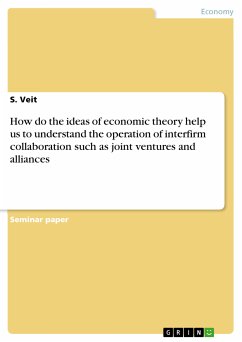Seminar paper from the year 2005 in the subject Economics - Innovation economics, grade: B, University of Groningen, course: Strategy and Innovation, language: English, abstract: In the contemporary business world nobody survives alone. An organization that wants to succeed must follow the rapidly changing environment. Major requirements for successful activity on the market are openness to innovations and the ability to enter into an alliance with other organizations and even competitors. “Strategic” or “corporate” alliances formed at high levels often fail to deliver real benefits to the partners. Analysts and managers will argue eternally over what caused each link-up to fail. Some blame egos and clashing cultures; others cite business conflicts and ruthless competition. Yet these cases of unfulfilled promises typically share one syndrome: the creation of the big alliance came to be seen as an end in itself rather than a means to a broader strategic goal (Gomes-Casseres, 1998). Therefore, an alliance without a comprehensive strategy behind it has a large probability of failure. Moreover, not all strategies lead to success. This research involves exploring strategic alliances in the computer hardware sector, the most innovative sector of the economy. Using the example of IBM, I aim to show that a strategic alliance can be successful if it is driven by innovation. In other words, two companies that form an alliance for the purpose of development and advancement of a new product or technology are likely to be successful. Admittedly, the presence of the innovation factor may not necessarily be the main reason for the success of the strategic alliance. Nevertheless, alliances based on joint innovation development are more lasting and productive than those that are not. I also hope to show how innovations help companies determine a strategy for their alliance. The following section presents a literature review on the strategic alliance, its purpose, and its expectations. The subsequent two sections present the research questions and model the problem, using the EFQM Excellence Model to estimate the success of the strategic alliance in achieving its purpose. The last two sections discuss the methods and data necessary for this study, and then present the conclusion.
Bitte wählen Sie Ihr Anliegen aus.
Rechnungen
Retourenschein anfordern
Bestellstatus
Storno









